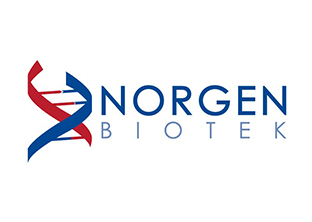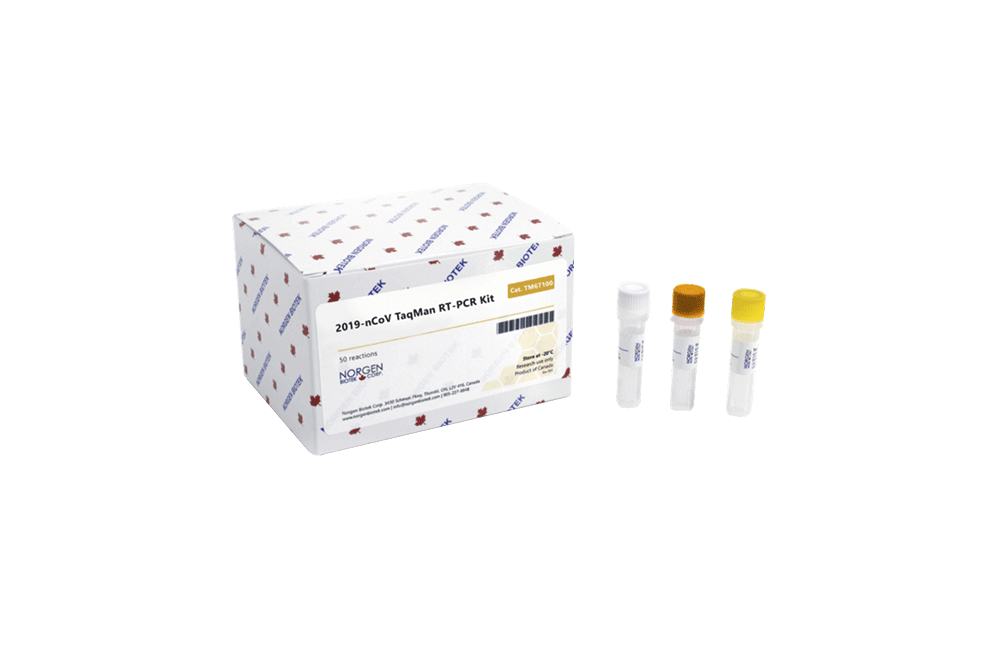
2019-nCoV TaqMan RT-PCR Kit
Detection kit for SARS-CoV-2, which causes COVID-19 (2019-nCoV)
Ready to use format containing everything required for detection
Available in 1 format for analysis:
For our COVID-19 information brochure click here


Detection kit for SARS-CoV-2, which causes COVID-19 (2019-nCoV)
Ready to use format containing everything required for detection
Available in 1 format for analysis:
For our COVID-19 information brochure click here

2019-nCoV TaqMan RT-PCR Kit
Norgen’s 2019-nCoV TaqMan RT-PCR Kit is designed for the detection of SARS-CoV-2 specific RNA in a real-time RT-PCR based on the use of TaqMan technology. This kit is designed for research use only and not for use in diagnostic procedures. The detection of SARS-CoV-2 specific RNA is based on TaqMan one-step RT-PCR providing a simple, reliable and rapid result for the detection of SARS-CoV-2 infection. Norgen’s 2019-nCoV TaqMan RT-PCR Kit includes a PCR control to monitor for PCR inhibition, and to validate the quality of the sample and the detection result. The 2019-nCoV TaqMan RT-PCR Kit comprises Master Mix for the target and PCR control detection, 3 target Primer & Probe Mixes, as well as a positive control and a negative control (nuclease-free water) to confirm the integrity of the kit reagents.
Norgen’s 2019-nCoV TaqMan RT-PCR Kit provides SARS-CoV-2 detection based on the assays and protocols developed by the CDC. The Primer & Probe Mixes contain all 3 CDC developed assays in individual tubes. All assays are premixed to the working concentrations recommended by the CDC. The Positive Control contains two nCoV nucleocapsid target gene RNA (N1 and N2) and RNase P (internal control).
Background information
In December 2019, an outbreak of respiratory illness started in Wuhan City, Hubei Province, China and has now spread throughout the world to many different countries. This respiratory disease was caused by a novel coronavirus and was initially termed “2019 novel coronavirus” or “2019-nCoV”, however in February of 2020 the World Health Organization (WHO) announced that the official name of the disease is COVID-19. The official name of the coronavirus causing COVID-19 is SARS-CoV-2.
SARS-CoV-2 is a new strain of coronavirus infecting humans that had not been previously detected before the outbreak in China in December 2019. While SARS-CoV-2 is new, many coronaviruses have been known to infect animals and humans for some time. Coronaviruses are known to commonly infect camels, cattle, cats, and bats. In humans, Coronavirus infections can cause various illnesses from the common cold to more severe diseases such as Middle East Respiratory Syndrome (MERS) and Severe Acute Respiratory Syndrome (SARS).
Human infection is more severe when the coronavirus has originated in animals and spread to humans, as is the case with MERS and SARS. SARS-CoV-2 is a betacoronavirus, similar to MERS and SARS, both of which have their origins in bats. The animal source of SARS-CoV-2 has not yet been identified, however Chinese officials have linked many of the early cases to a large seafood and live animal market, suggesting that the initial transmission was the result of animal-to-person spread. However, many of the later detected cases did not report any exposure to animal markets, indicating that the virus is now spreading via human-to-human contact.
Symptoms of infection with SARS-CoV-2 can range from milder symptoms such as a runny nose, sore throat, cough, and fever to more severe symptoms including pneumonia or breathing difficulties. In some cases infection with SARS-CoV-2 has resulted in death. As with other respiratory illnesses, older people and individuals with pre-existing medical conditions (such as diabetes or heart disease) are more vulnerable to becoming severely ill with the virus.
Storage Conditions and Product Stability
All kit components should be stored at -20°C upon arrival Repeated thawing and freezing (> 2 x) of the Master Mix and Positive Control should be avoided, as this may affect the performance of the assay. If the reagents are to be used only intermittently, they should be frozen in aliquots. All reagents can be stored for 6 months at -20°C without showing any reduction in performance.